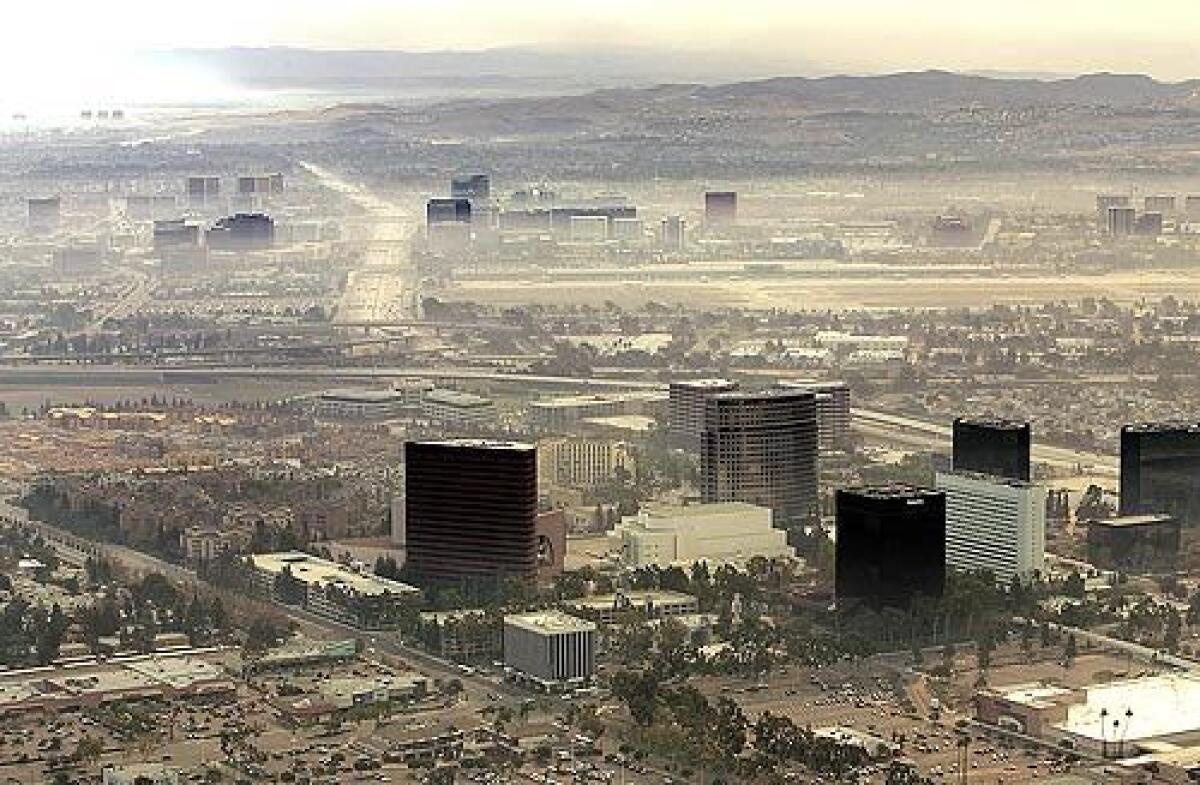Fire-area residents still waiting to inhale

- Share via
The state’s smog czar warned Wednesday that unhealthful conditions caused by smoke from wildfires are likely to persist throughout much of Southern California until next week.
Even when the fires are extinguished and the Santa Ana winds that carried their smoke die down, the tiny particles suspended in the air could remain in hazardous concentrations “into next week,” said Mary Nichols, chair of the California Air Resources Board.
“Our advice for everybody’s health, even for people who are healthy, is they should be taking it easy and staying indoors,” Nichols said.
Pollution measurements throughout much of the Los Angeles Basin and San Diego County have peaked at levels up to 10 times higher than levels deemed safe by national health standards. Such extreme concentrations of particulates, even if they last a few hours or less, are considered hazardous, capable of causing immediate breathing problems even for healthy people.
In Escondido just after midnight Tuesday, fine particulates reached 325 micrograms per cubic meter of air, according to a California Air Resources Board website. The federal government’s health standard for acceptable exposure over 24 hours is 35 micrograms per cubic meter of air. The state air board put mobile monitors in five fire areas in San Diego County shortly after the fires erupted this weekend to detect the highest concentrations.
On Monday in Norco/Corona and Lake Elsinore, levels reached concentrations exceeding 200 micrograms per cubic meter, according to data from the South Coast Air Quality Management District.
Particulates are microscopic pieces of soot, smoke, dust or other materials capable of lodging deep in lungs.
Because of strong Santa Ana winds moving toward the coast, some of the worst smoke is accumulating many miles from fires, including in Long Beach, Simi Valley and the Riverside area.
Pollution concentrations were decreasing region-wide Wednesday, but many areas still exceeded health standards.
“The air quality is officially designated as unhealthful,” Nichols said. “There is widespread exposure. . . . This is something that everybody should be paying attention to.”
Particulates in the smoke aggravate asthma, emphysema, heart disease and other respiratory and cardiovascular conditions. They also can irritate healthy lungs and airways, causing coughing and shortness of breath, stinging eyes, headaches and stuffy noses.
State and local health officials are urging people throughout the fire region to stay indoors with windows shut, use air conditioning if possible and avoid strenuous outdoor activity.
Some hospital officials reported a moderate increase in patients with respiratory problems. Travis Henson, an emergency room physician at Providence Holy Cross Medical Center in the northeast San Fernando Valley community of Mission Hills, said larger-than-normal numbers of patients with asthma, chronic bronchitis and emphysema had shown up this week.
Henson said he noticed a relatively high number of children with cold symptoms and respiratory problems. Some of these young patients, he said, “maybe have never had asthma before.”
Cheryl Evans-Cobb, director of emergency services at West Hills Hospital and Medical Center in the west San Fernando Valley, said she had noticed a slight upturn as well. And among the staff, “lots and lots of people have their fire cough,” she said.
Studies show that deaths and hospitalizations from lung and heart diseases, particularly bronchitis, asthma and pneumonia, increase in the days after wildfires.
“Our first concern is individuals with pre-existing chronic conditions like heart disease, chronic lung disease like emphysema, and intermittent diseases and conditions like asthma,” said Dr. Mark Horton, the state’s Public Health director. “Smoke can certainly exacerbate those conditions.”
In addition to particulates, smoke from wildfires carries a mix of toxic substances, including carbon monoxide, hydrocarbons, nitrogen oxides and traces of heavy metals from the Earth’s crust. The fires also are emitting large volumes of carbon dioxide, methane and nitrous oxide, which have been linked to global warming.
Tom Bonnicksen, a forestry and wildfire expert who is a professor emeritus at Texas A&M University, estimates that 19 million tons of greenhouse gases have been emitted by this week’s fires. That is equivalent to 3.5% of annual emissions generated statewide from all sources.
Nichols said the state’s greenhouse gas inventory already builds in estimates for wildfires. This year’s total, however, could exceed that estimate, given the size of the Zaca fire in the Los Padres National Forest this summer and this week’s blazes.
Times staff writer Stuart Silverstein contributed to this report.
More to Read
Sign up for Essential California
The most important California stories and recommendations in your inbox every morning.
You may occasionally receive promotional content from the Los Angeles Times.









